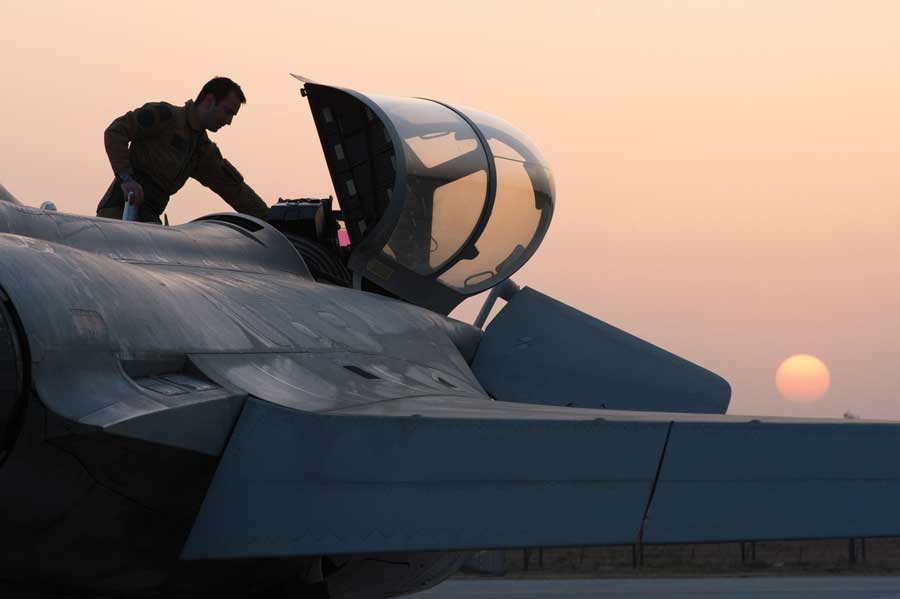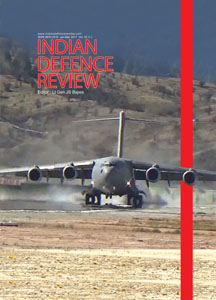Formally established on 08 October 1932, the IAF will be celebrating its centenary of extraordinary service to the nation, in 2032. Beginning with just four Wapiti aircraft and six pilots, the IAF is transforming into a formidable aerospace force. The process was initiated from the turn of the century, or maybe even a little earlier, and by its centenary year, it will have assets and capabilities, which would be the envy of any air force of the world. The expectations of the country, from the IAF, are high; as it marches with confidence towards its centenary, the IAF is ever ready to live up to the expectations.
The IAF is not just concentrating on modernising its combat fleet, it is also in the process of building on its impressive strategic airlift capability…
Air power, in its short history as compared to the other fighting arms, has seen more technological innovations than the others, thus affecting the very concept of force projection and conduct of war. From the first instance of using the medium of air in 1911, during WW I, to becoming the cutting edge of an invasion in WW II, air power has matured into a notable fighting arm; it can be said that the use of the third dimension to enhance military capabilities had developed and settled during WW II. General Eisenhower put emphasis in his words when he stated, “The Normandy landings were based on a deep-seated faith in the power of the Air Force in overwhelming numbers to intervene in the land battle.” Ever since that era, aviators, over the world, have been putting forth their case that airpower should hold centre-stage in any war and have proven it on many occasions in recent conflicts.
Over time, the use of air combat power has gained prominence in military operations. Today, we have to factor the use of space as well. Space power has incrementally demonstrated its huge potential for military planners to perforce combine its employment with the conventional means. Operation Desert Storm (also known as the Gulf War of 1991) first demonstrated the true contribution of air and space power. Air power took a quantum leap in reliability and importance after the initial days of the conflict, with a legacy to follow. Aerospace power had come to stay!
The Legacy of Desert Storm
With the passage of time, analysts tend to grow wiser and so has been the case in the analysis of the Gulf War of 1991. The war, as one has always been led to believe, was not as much of a towering strategic success as claimed by the US-led coalition. Many of the goals articulated by the military leaders before the commencement of the war were not realised. General Colin Powell had asserted in respect of the Iraqi Army, “…first we are going to cut it off, and then we are going to kill it…” CENTCOM had declared its objective of destroying Iraq’s capability of manufacturing Weapons of Mass Destruction (WMD). Neither was achieved; if the success had been as claimed, where then was the need for a second war of Iraq?
Russia, being the main supplier of military hardware and doctrine to Iraq, was closely following the progress of Desert Storm!
Notwithstanding the debates and continuing analysis, the use of aerospace power was without doubt, decisive. The successes in the air and against the ground forces are sure to keep Desert Storm in the list of winning campaigns for some time to come, with studies by armchair analysts all over the world. Interestingly, some of the most insightful comments on the use of airpower, made possible by new technologies and hence, a changed concept of operations, have come not from the US or its partners, but from Russian defence professionals. Russia, being the main supplier of military hardware and doctrine to Iraq, was closely following the progress of Desert Storm!
While historians, analysts, and observers, will have the last word, it is an accepted fact that the coalition’s technological edge over Iraq made an important difference in shaping the outcome of the war. High technology not just contributed, but was the sole reason of the victory; superior training, motivation, proficiency, leadership and boldness in execution assisted in shaping victory.
Transition in Roles of Air Power
The primary role of air power has generally been accepted to gain and maintain air superiority. Having achieved air superiority, it was then pushed in to a support role, providing fire-power and other sustaining functions to land and maritime forces. If air power is to genuinely create effects, as is being demanded from it, the current roles will also have to be given a boost to conform to this paradigm. Until some years ago, air power did not have the capability of precision with an acceptable assurance, leading to unacceptable collateral damage in surface attack missions. It did not have much loiter-time over target areas, nor was it able to provide the rapidity that is so essential today. Proficient use of cutting-edge technology has almost eliminated these gaps to an extent that air power today has become the primary instrument of choice in waging any type of war.
The primary role of air power has generally been accepted to gain and maintain air superiority…
While air power may be the first choice of military planners to wage war, it cannot be effective without enabling operations. All operations that facilitate and shore up the effective employment of air power come under this generalised caption. This would include Air-to-Air Refuelling (AAR) missions, which provide the focus on reach and time-over-target, early warning and control activities, be they air or surface-based; information operations, including collection, collation and dissemination of relevant information and reconnaissance. To the last, one can add the dependency on space-based information, which has increasingly displayed its import. All force projection capabilities are becoming increasingly dependent on space operations and the trend is only likely to amplify in the decades to come.
One, however, must not get carried away and ask for the moon, for resource limitations will force the prioritisation of various factors to determine the asset availability for a particular enabling operation. There, hence, is a need to balance the force projection capability with force protection and enabling operations. The balance cannot be specified since requirements would vary as per situation, the most influential being in the context and theatre of operations.
Geo-Politics
Crystal ball gazing in geo-politics is an extremely difficult task. At the time of Desert Storm, who could have predicted the events that have followed it, would have an intense effect not just on India, but the entire world? The end of the Cold War was supposed to herald an era of peace. The world, however, has been witness to more conflicts than ever before, with current threats of a re-emergence of the Cold War. The unification of Germany created a strong nation in Europe, which assumed the leadership to pull the European Union (EU) out of the many economic upheavals that it has been facing, the Brexit and the refugee crisis being the latest!
The end of the Cold War was supposed to herald an era of peace…
The proliferation of Islamic terror has assumed horrific proportions after 9/11. It was expected to reduce, if not end, with the killing of Osama bin Laden. Yet just as the Greek mythological monster “Hydra” when one head is cut-off, another two sprout in its place. India going nuclear, closely followed by Pakistan and the continuing support to terrorism by Pakistan, under the threat of use tactical nukes, has affected military planning in India, with consequential effects on the economy and development of the nation. These events and more had their genesis in the 20th century, but continue to have an intense effect on the world and in particular, our region. India is located in a dynamic region. It is difficult to keep up with the changes and policies therefore, the need for utmost care in planning and manoeuvering, to avoid constant corrections.
If, for the moment, we disregard the debate on whether India has a strategic culture or not, it can be said with some degree of assurance that, over the decades after independence, India has developed an attitude that is based not on soft power but on realpolitik and geopolitical issues. Numerous examples highlight this fact, where India has taken some difficult decisions, be they in bi-lateral meetings or in international forums to balance its relations with immediate neighbours or other friendly nations. The vote on Sri Lanka in the UN Human Rights Commission, the continuing engagement with Myanmar and Iran, notwithstanding the pressures from USA, India’s oil exploration treaties with Vietnam and ‘expeditions’ in the South China Sea, the abstention in the United Nations on the vote on Russia’s annexation of Crimea, are just a few to name.
An effective foreign policy of any nation needs to be aptly supported by a strong military. The blitzkrieg in the country’s foreign policy, initiated by the Prime Minister, in translating good relations into strategic relations, hence, requires an adequate military support. Not to deride the role and capabilities of other Services, but the strike-power of any nation today, rides on air power, as has been amply demonstrated in the recent conflicts. And so is the case with India. The Army is essential to control territory with boots on ground; the Navy for securing the Sea Lanes of Communication (SLOC) and other assets on the sea, so essential for trade and commerce but the IAF, with the primary task of guarding the Indian skies and its national interests and other assets, is the important tool for air power projection.
The Current Status of the IAF
Combat aircraft are the ‘Brahmastra’ of any air force and the IAF is no exception. Modernisation and upgrade which are ongoing processes, help maintain the combat edge at all times. The fleet of Mirage 2000, Jaguar and the Mig-29 are being upgraded to meet the needs of the future, while the acquisition of SU-30 MKI has become the muscle of the combat fleet. Some of the older fleets, such as the MiG 21 and MiG 27, are on the verge of being phased out. The established strength of 42 combat squadrons hence, is likely to reduce to 30 squadrons in the next three years or so. To arrest the depleting force levels and the resultant erosion of the fighting potential, the IAF has embarked on the mid-life upgrade/modernisation of some of the other fleets. These upgrades would help the fleet to render cutting-edge service for another two to three decades, if not more.






